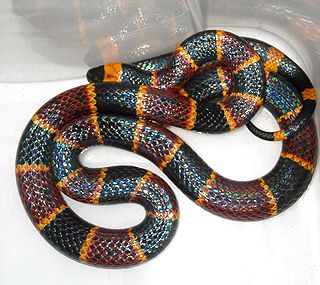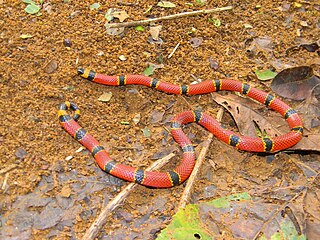
Kingsnakes are colubrid New World members of the genus Lampropeltis, which includes 26 species. Among these, about 45 subspecies are recognized. They are nonvenomous and ophiophagous in diet.

Coral snakes are a large group of elapid snakes that can be divided into two distinct groups, the Old World coral snakes and New World coral snakes. There are 27 species of Old World coral snakes, in three genera, and 83 recognized species of New World coral snakes, in two genera. Genetic studies have found that the most basal lineages have origins in Asia, suggesting that the group originated in the Old World. While new world species of both genera are venomous, their bites are seldom lethal; only two confirmed fatalities have been documented in the past 100 years from the genus Micrurus. Meanwhile, snakes of the genus Micruroides have never caused a medically significant bite.

Micrurus is a genus of venomous coral snakes of the family Elapidae.

Micrurus tener, commonly known as the Texas coral snake, is a species of venomous snake in the family Elapidae. The species is native to the southern United States and adjacent northeastern and central Mexico. Six subspecies are recognized as being valid, including the nominotypical subspecies, Micrurus tener tener The species Micrurus tener was once considered to be a subspecies of the eastern coral snake.

Micrurus fulvius, commonly known as the eastern coral snake, common coral snake, American cobra, and more, is a species of highly venomous coral snake in the family Elapidae.The Elapidae family also contains the cobras and sea snakes. The species is endemic to the southeastern United States. It should not be confused with the scarlet snake or scarlet kingsnake, which are harmless mimics. No subspecies are currently recognized.

Bothrops jararacussu, commonly known in English as the jararacussu, is a highly venomous pit viper species endemic to South America. It is one of the most dreaded snakes in South America and can grow up to 2.2 metres (7.2 ft).

The forest cobra, also commonly called the black cobra and the black and white-lipped cobra, is a species of highly venomous snake in the family Elapidae. The species is native to Africa, mostly the central and western parts of the continent. It is the largest true cobra species with a record length of 3.2 metres.

Micrurus nigrocinctus, commonly known as the Central American coral snake, is a species of a highly venomous snake in the family Elapidae. The species is endemic to Latin America from southern Mexico, Central America, to north Colombia. There are six recognized subspecies, including the nominate subspecies described here.

Micrurus stuarti is a species of venomous snake in the family Elapidae. The species is endemic to Guatemala. There are no recognized subspecies.

Bothrops moojeni, commonly known in English as the Brazilian lancehead, is a species of venomous snake in the family Viperidae. It is a pit viper endemic to South America.

Micrurus browni, commonly known as Brown's coral snake, is a species of venomous snake in the family Elapidae. The species is native to Guatemala and southwestern Mexico. There are three recognized subspecies, including the nominate subspecies described here.

Pentaclethra macroloba is a large and common leguminous tree in the genus Pentaclethra native to the wet tropical areas of the northern Neotropics, which can form monocultural stands in some seasonally flooded habitats. It has giant, bipinnate leaves shaped like feathers. It uses seed dispersal by water to establish itself in new areas, having floating seeds that are left behind after the waters recede after floods or tides. It has hard timber which is not very resistant to rot in the tropics, but it can be treated, has a pretty pink-red colour when dry, and has a number of uses. Oil used in cosmetics is extracted from the large seeds. In the northern Amazon region the bark is used in herbal medicine as an antivenom, and in the Guianas the bark has been used as a fish poison. Despite their toxicity, the seeds are eaten by variegated squirrels, parrots and macaws, and serve as the nurseries of the larvae of the moth Carmenta surinamensis.

Micrurus lemniscatus, commonly known as the South American coral snake, is a species of venomous snake in the family Elapidae. The species is endemic to South America.

Micrurus annellatus, commonly known as annellated coral snake, is a species of venomous elapid snake native to southeastern Ecuador, eastern Peru, Bolivia, and western Brazil. There are three recognized subspecies, including the nominate subspecies described here.

Micrurus corallinus is a species of highly venomous elapid snake native to South America. There are no recognized subspecies.

Micrurus frontalis, also known as the southern coral snake or short-tailed coral snake, is a species of highly venomous coral snake in the family Elapidae. It is found in South America.

Micrurus mipartitus is a species of coral snake in the family Elapidae. The species is native to Central America and northern South America. The red-tailed coral snake is common in agricultural areas in Colombia. Its highly neurotoxic venom is known to cause seizures in its prey by activating nerve proteins responsible for seizures within it.

Snakebite envenomation is considered a public health problem in Latin America, with an estimated 70,000 cases annually, but due to underreporting, these numbers may be even higher.

Philodryas patagoniensis, also known as the Patagonia green racer, is a species of rear-fanged (opisthoglyphous) venomous snake in the family Colubridae. The species is endemic to cis-Andean South America from northern Argentina to northeastern Brazil; despite its name, most of its range is outside Patagonia.

Philodryas nattereri, the Paraguay green racer, is a species of venomous snake, endemic to South America.






















